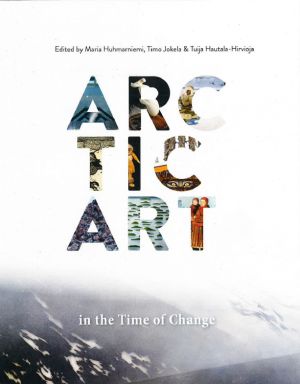A special issue of the 2019 Synnyt Journal, edited by Maria Huhmarniemi, Timo Jokela and Tuija Hautala-Hirvioja, has been published. The volume includes articles from around the Circumpolar North and encourages discourse about the role of art in the development of the Arctic.
concept of Arctic art has been used to define art and design practices that reflect and reform the cultural heritage of the Arctic region. One of the editors, Maria Huhmarniemi, describes the concept of Arctic art in the following way:
"Arctic art includes indigenous and nonindigenous art, as well as the interaction between them. It refers to contemporary art, traditional crafts and new art forms, such as snow installations. Media art productions that depict Arctic culture are also Arctic art. The concept is politically loaded and calls for sustainable development."
In the issue's first article, Hanna Lempinen explores themes of culture and sustainability through the lens of social science. Lempinen claims that state-level Arctic strategies, supported by theA council's member states, do not prioritise culture to any meaningful extent. Strategies most commonly refer to art and culture in the context of indigenous peoples.
Art historian Tuija Hautala-Hirvioja studies the artistic portrayal of the Arctic in an article titled "Early Artists in the Euro-Arctic Region: Arctic Culture and Nature as a Motif in Art from the 1870s to the 1930s".
In a third article, called "A Context-Sensitive Approach to the Use of Traditional Ornaments in Contemporary Design Practice", design researchers Ramilya Minnakhmetova, Svetlana Usenyuk-Kravchuk and Yulia Konkova examine the aesthetic value of Arctic natives' traditional ornaments and challenge assumptions that such ornaments are mere decorations.
Elsewhere in the issue, Maria Huhmarniemi and Timo Jokela, both experts in art education and applied visual arts, examine the potential for environmental art in sustainable tourism in the Arctic. The authors propose that the sustainable retention and reformation of cultures in the Arctic region can come though art. Art historian Hanna Horsberg Hansen also analyses the artwork Pile o'Sapmi by Sami artist Maret Anne Sara from multiple perspectives.
The final three contributions to the volume are visual essays. In "Changes: Icelandic Artists Reflect on Climate Changes", researcher-curator Asthildur Jonsdottir discusses artworks that reflect on natural elements. Alaskan art educator Herminia Din presents a personal journey with Alaskan natives in the essay "Storytelling and Interchanges: Sewing Art from Siberian Yupik on St. Lawrence Island, Alaska". Meanwhile, Nicole Bauberger and Amanda Graham illustrate a research project undertaken in Whitehorse, Canada, in the essay "Needle, Bead and Voice: Learning about Yukon First Nations Traditional Sewing from Mrs. Annie Smith and Ms. Dianne Smith".
One of the editors and the leader of the Arctic Sustainable Art and Design Network, Timo Jokela, highlights the importance of the discussion on Arctic art:
"We should understand that the role of art and culture is vital for the well-being of the Arctic people, as well as the whole of society. The aim of increasing collaboration among circumpolar scholars is connected to cultural and educational policies, through which new ways of linking art with other sectors of society can be established."
Lapin yliopiston taiteiden tiedekunnan julkaisuja. Sarja C. Katsauksia ja puheenvuoroja
ISSN 1236-9616













